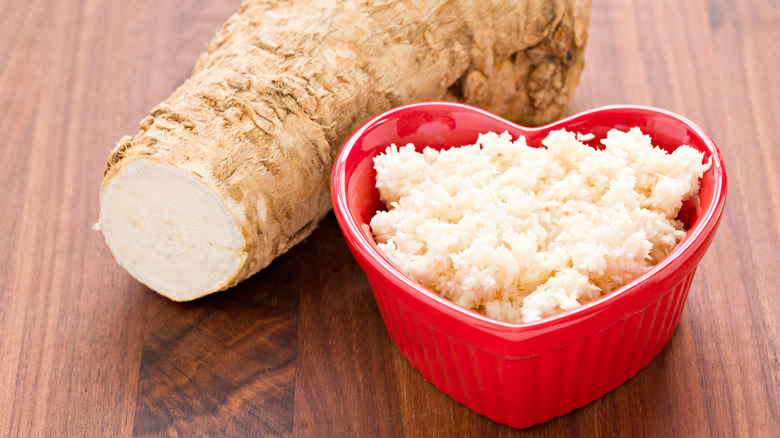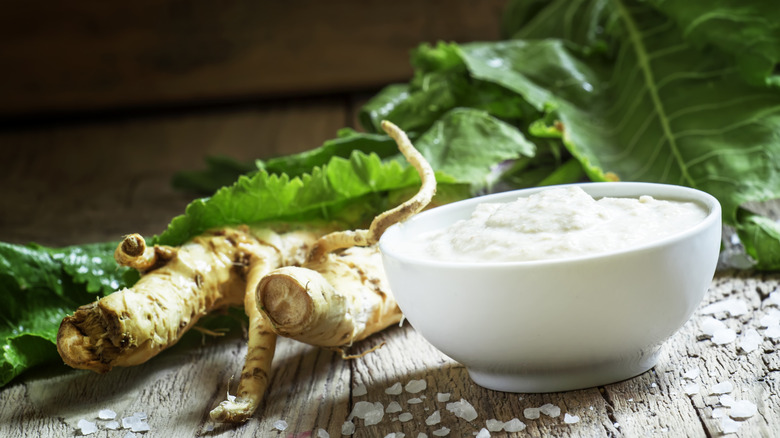The Differences Between Fresh And Dried Horseradish
The food substance we call horseradish is so seldom seen in most supermarkets that you could be forgiven for thinking it grows in jars. Many people can't get enough of this pungent, tangy stuff — particularly when it's calmed down by things like mayonnaise in a creamy sauce that's simply dynamite with prime rib. Heck, a lot of us have been eating horseradish as a stand-in for the actual wasabi in sushi restaurants. Horseradish comes to us in essentially two forms: fresh and dried. So, what's the difference? Simply put, fresh horseradish is a vegetable; dried horseradish is a spice.
As a member of the cabbage family, horseradish is a perennial plant related to other edibles like broccoli and, yes, wasabi. While its leaves look a little like mustard greens (another relative), it's the plant's roots that we love to eat. You can buy prepared horseradish at the store or get your hands on the long, thick root and use that for cooking. You can also buy horseradish powder, which is fascinating in and of itself.
Horseradish the spice
Horseradish root powder is, as you might imagine, ground and dried horseradish root. Like wasabi, it is fiery, a little bitter, and good for clearing your sinuses. The one thing about horseradish powder (that distinguishes it from other spice agents) is that it quickly loses its bite when heated, which is why it's often used in sauces that don't need to be cooked — chief among them the aforementioned horseradish sauce, accompanied by sour cream, mayonnaise, heavy cream, or a combination of all three. Because of its assertiveness, you won't need much of this stuff; consider using a heaping teaspoon for every ⅓ cup of sauce.
You can also use horseradish spice along with sour cream in making a dressing for salmon, or combine it in a saucepan over low heat with raspberry preserves, vinegar, ketchup, soy sauce, and minced garlic for a sauce to accompany pork medallions. The possibilities are practically endless; just keep the heat low.
Horseradish the vegetable
Let's say you're able to get your hands on fresh horseradish, either in the grocery store or from a gardening supply company (the plant will sprout from the rhizome and is relatively easy to grow). What the heck do you do with the thing? It might look a little like a parsnip, but trust us: You don't want to throw an entire horseradish root into your next pot pie filling. Even the fresh stuff has a kick.
Wash the horseradish, peel it like a carrot, and grate it. You can mince it too, but the core might be a little tricky. (Oh, and be advised: The more finely grated or minced the root is, the spicier it gets.) This can also be done in a food processor, but don't lean in and take a big whiff, lest your face detach. Whisk grated horseradish into mayonnaise, prepare it with vinegar and salt, and use in a roasted fennel sauce for Christmas rib roast or stir it into a potato soup or your next bacon Bloody Mary. If you really love the stuff, put some grated horseradish root in a bottle of vodka to create an intense infusion the Russians call khrenovukha, which is typically consumed in shots and accompanied by slabs of cured meat. Za vashe zdorovie!


